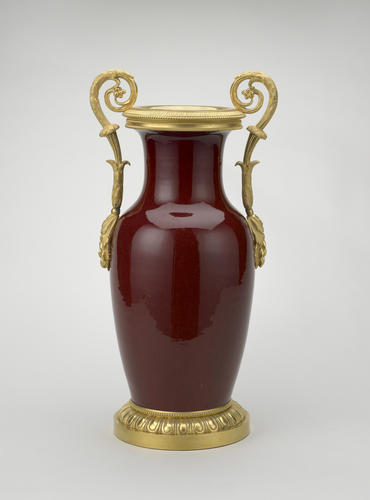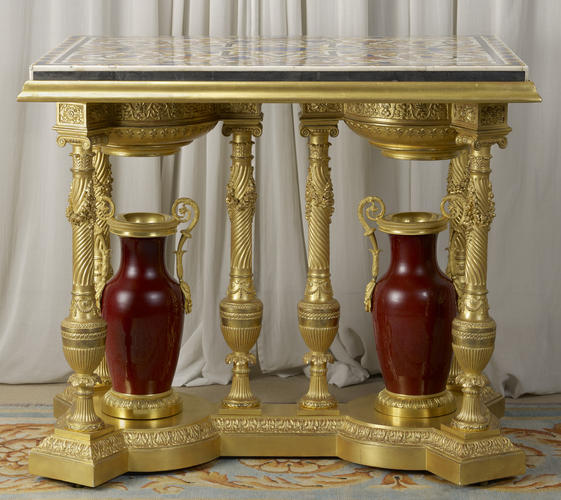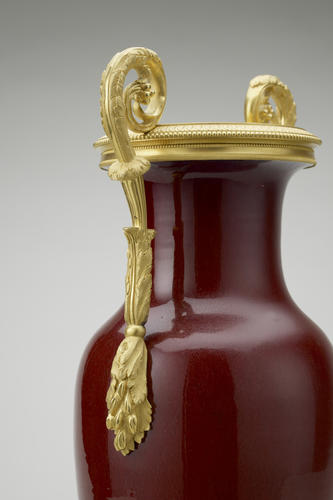Table with pair of mounted vases late 18th-early 19th century, mounts: early 19th century
Gilt wood, porcelain with flambé copper-red glaze and gilt bronze | 83.5 x 95.2 x 68.2 cm (whole object) | RCIN 20583

China
Master: Table with pair of mounted vases Item: Vase late 18th-early 19th century, mounts: early 19th century



-
Carved and gilt table inlaid with pietra dura. Polychrome marble with blue and gold geometric pattern and black eight pointed star. Six supporting legs with spiral grooves and swags of foliage, one at each corner inset, two in centre, all richly carved. Below are mounted a pair of Chinese porcelain red porcelain vases with French gilt-bronze mounts. With ovoid body and broad neck with everted lip, the base with a crazed, greenish glaze; a hole bored in the base for attaching it to a table. The circular top rim is encased in an everted leaf-cast ring, with disc inside the plain inner lip to close the vase’s mouth. The outer beaded edge above a plain concave moulding, with a ring of beads and milled lower edge. At each side is attached a handle of scrolled acanthus, descending into a reeded section which is enclosed by an acanthus clasp, terminating in a berried acanthus drop; the handles rest on the side of the vase and do not pierce the vase’s body. The circular foot is set into a beaded ring above a further gadrooned ring and plain circular plinth; the latter two elements are probably early twentieth century in date, probably by Hatfield. The underside with brass plaque with two locating holes; both stamped on the brass plaque, ‘H.J. HATFIELD / LONDON’.
The gilt-wood table under which the vases sit was made by joining two three-legged pedestals, originally used to support a gilded and patinated bronze candelabra with a central tapering vase element painted in blue enamel. The pedestals were partly gilded and partly ebonised and a gilt-metal basket with pierced basket-weave sides was suspended between the legs. They stood on the staircase at Carlton House until they were despatched to Windsor Castle on 1 February 1834 (Carlton House Inventory, volume H, p. 125) They were depicted in a pencil and watercolour illustration by G.P. Moore, dated 26 August 1826 included in the ‘Pictorial Inventory’, property from Carlton House to be considered for use at Windsor Castle (RCIN 934823). At an unknown date after 1834 the two pedestals were made into a single table in order to display the vases and the pietre dure slab top which had been purchased in Paris from the dealer Delahante by Sir Charles Long on behalf of George IV and received at Carlton House 25 February 1825 (Jutsham Recs II.185).
While the rare copper-red glazes of the early Ming period underwent a revival at the court of Kangxi (1662–1722), the period is better known in the West for its creation of the strikingly brilliant sang-de-boeuf wares. These are subject to uneven effects of colour owing to the fugitive quality inherent in the medium. Later in the eighteenth century, it resulted also in the making of flambé wares with purplish markings, which are at times due to the deliberate addition of cobalt blue.
Text adapted from Chinese and Japanese Works of Art in the Collection of Her Majesty The Queen: Volume II.Provenance
The pair of vases were almost certainly acquired by George IV. The Brighton Pavilion Inventory lists ‘A pair of marone China jars, mounted with ormolu rims, bases and scroll handles, seventeen inches [43.2 cm]’ (1829B, p. 91). Perhaps those described as ‘with chocolate ground, ormolu base, scroll handles’, listed in the ‘1866’ Windsor Castle Inventory, pp. 188–9, no. 275, Room 218.
-
Creator(s)
(nationality)(metalworker)Acquirer(s)
-
Medium and techniques
Gilt wood, porcelain with flambé copper-red glaze and gilt bronze
Measurements
83.5 x 95.2 x 68.2 cm (whole object)
44.0 x 22.5 x 10.5 cm (whole object)
Category
Object type(s)
Other number(s)







